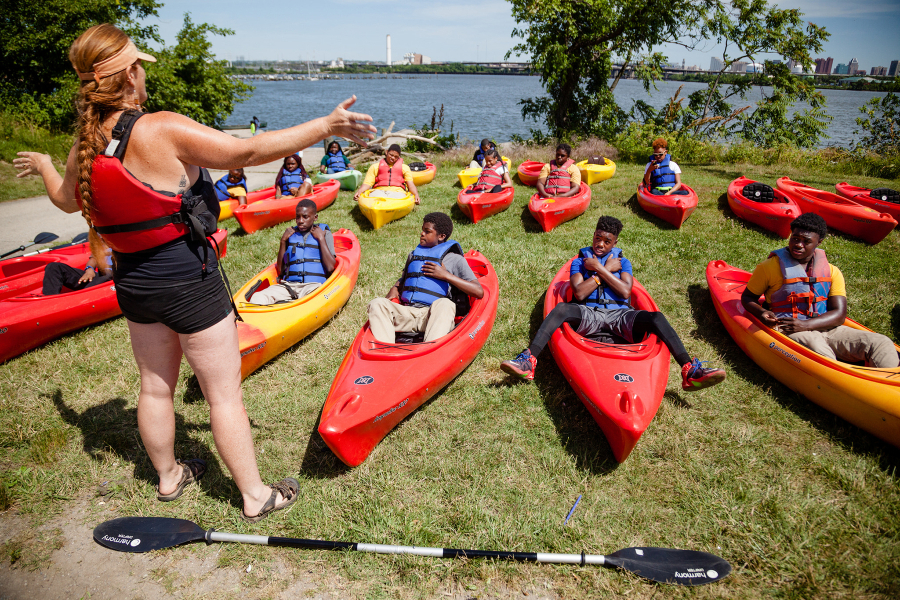Fostering Chesapeake Stewardship Goal Implementation Team (GIT 5)
The Fostering Chesapeake Stewardship Goal Implementation Team fosters a greater connection between the public and the Chesapeake Bay watershed by supporting conservation initiatives, increasing public access to waterways, supporting environmental education, increasing stewardship actions and embedding diversity, equity, inclusion, justice and accessibility throughout the Chesapeake Bay Program’s work.

The Fostering Chesapeake Stewardship Goal Implementation Team (GIT 5) aims to foster a greater connection between the public and the Chesapeake Bay watershed by supporting conservation initiatives, increasing public access to waterways, supporting environmental education, increasing stewardship actions, and embedding diversity, equity, inclusion, justice, and accessibility throughout the Program’s work.
Upcoming Meetings
Stewardship Workgroup Meeting - May 2025
Tuesday, May 13, 2025 from 2:30pm - 4:00pmEducation Workgroup Meeting - July 2025
Monday, July 7, 2025 from 10:00am - 11:30amScope and Purpose
With over 17 million people living in the Chesapeake watershed, public participation is a vital piece of the restoration effort. The Fostering Chesapeake Stewardship Goal Implementation Team’s charge is to increase individual stewardship action, support environmental education for all ages, and assist individuals, communities and local governments in undertaking initiatives to conserve treasured landscapes. The team hopes to reconnect the public with nature and foster a shared ownership of the Chesapeake’s diverse resources. This approach will build public support of restoration and conservation efforts and increase public engagement and active stewardship.
The Fostering Chesapeake Stewardship Goal Implementation Team (GIT 5) is pursuing the 2014 Chesapeake Watershed Agreement goals and objectives to:
Stewardship Goal: Increase the number and diversity of local stewards and local governments that actively support and carry out the conservation and restoration activities that achieve healthy local streams, rivers and a vibrant Chesapeake Bay.
- Stewardship Outcome: Increase the number and diversity of trained and mobilized volunteers with the knowledge and skills needed to enhance the health of their local watersheds.
Public Access Goal: Expand public access to the Bay and its tributaries through existing and new local, state and federal parks, refuges, reserves, trails and partner sites.
- Public Access Site Development Outcome: By 2025, add 300 new public access sites, with a strong emphasis on providing opportunities for boating, swimming and fishing, where feasible.
Environmental Literacy Goal: Enable students in the region to graduate with the knowledge and skills to act responsibly to protect and restore their local watershed.
- Student Outcome: Continually increase students’ age-appropriate understanding of the watershed through participation in teacher-supported, meaningful watershed educational experiences and rigorous, inquiry-based instruction, with a target of at least one meaningful watershed educational experience in elementary, middle and high school depending on available resources.
- Sustainable Schools Outcome: Continually increase the number of schools in the region that reduce the impact of their buildings and grounds on their local watershed, environment and human health through best practices, including student-led protection and restoration projects.
- Environmental Literacy Planning Outcome: Each participating Bay jurisdiction should develop a comprehensive and systemic approach to environmental literacy for all students in the region that includes policies, practices and voluntary metrics that support the environmental literacy Goals and Outcomes of this Agreement.
Land Conservation Goal: Conserve landscapes treasured by citizens in order to maintain water quality and habitat; sustain working forests, farms and maritime communities; and conserve lands of cultural, indigenous and community value.
- Protected Lands Outcome: By 2025, protect an additional two million acres of lands throughout the watershed—currently identified as high-conservation priorities at the federal, state or local level—including 225,000 acres of wetlands and 695,000 acres of forest land of highest value for maintaining water quality.
Publications
Call for Stewardship Co-Chair
This voluntary position leads and coordinates the work of the Stewardship Workgroup, with support from the GIT 5 coordinator and staffer. This is an opportunity to work with a broad team of partners within the Chesapeake Bay watershed representing government and nongovernment entities, to have significant impact on shaping and achieving commitments to public stewardship, and to diversifying the people who participate in and benefit from these efforts.
View detailsWatershed Agreement
Land Conservation Goal
Stewardship Goal
Public Access Goal
Environmental Literacy Goal
Workgroups and Action Teams
Members
Wendy O'Sullivan (Chair), National Park Service (NPS)
1750 Forest Drive Suite 130
Annapolis, Maryland 21401
Email: wendy_o'sullivan@nps.gov
Phone: (202) 374-9051
Britt Slattery (Coordinator), Fostering Chesapeake Stewardship Goal Implementation Team Coordinator, National Park Service (NPS)
Meredith Lemke (Staffer), Stewardship Goal Implementation Team Staffer, Chesapeake Research Consortium
Daniel Koval (Staffer), Stewardship Goal Implementation Team Staffer, Chesapeake Research Consortium
Shannon Sprague, Education Workgroup Coordinator, NOAA Chesapeake Bay Office
200 Harry S. Truman Parkway Suite 460
Annapolis, Maryland 21401
Email: shannon.sprague@noaa.gov
Phone: (410) 267-5664
